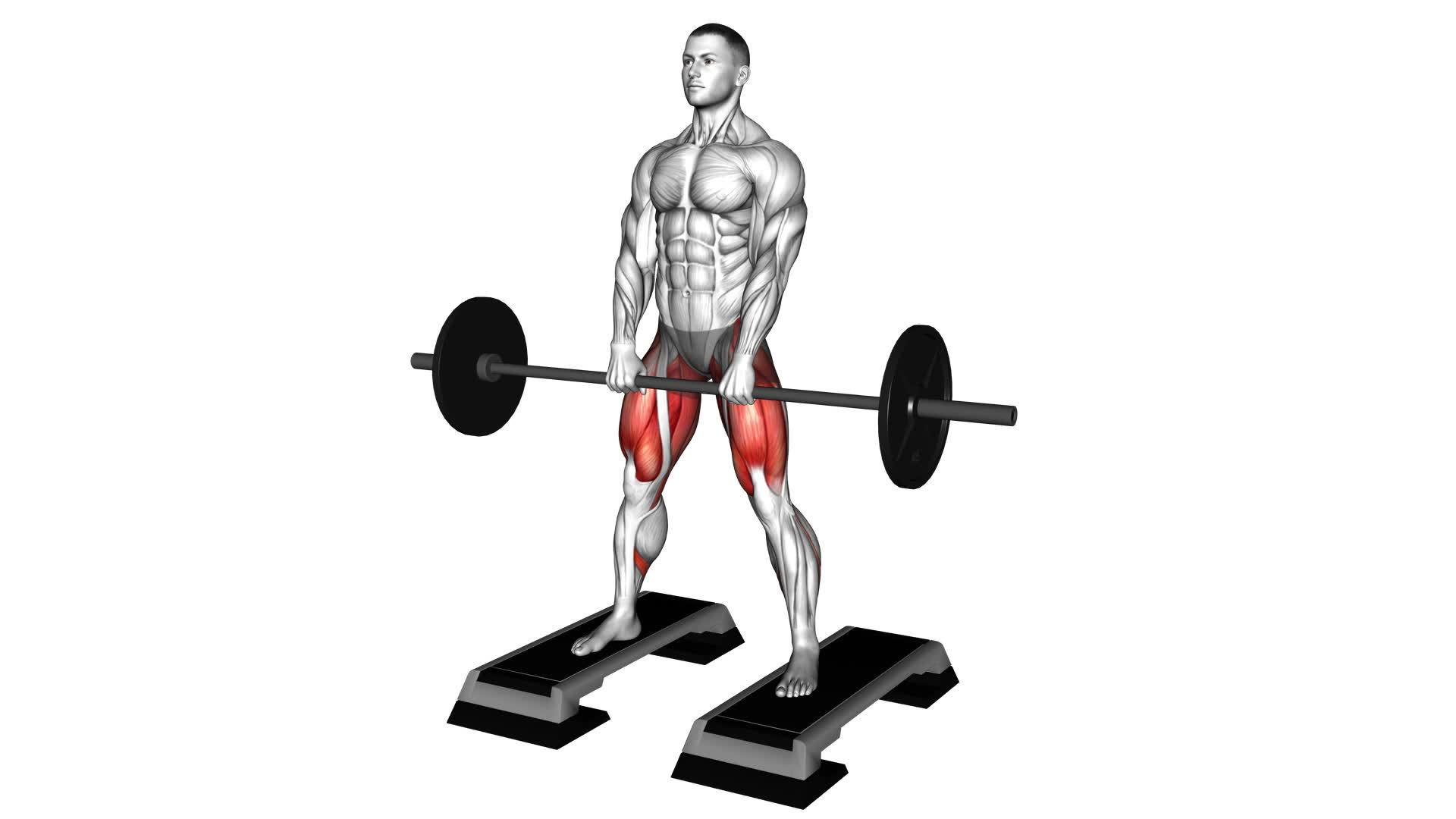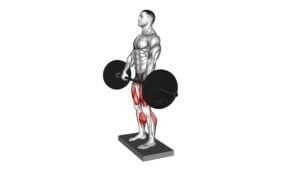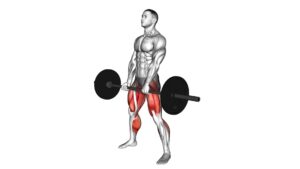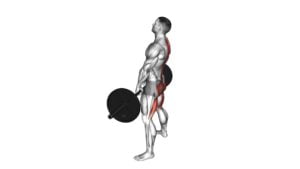Barbell Sumo Deadlift From Deficit – Video Exercise Guide & Tips

Are you looking to strengthen your lower body and improve your lifting technique?
Watch This Exercise Video
Look no further than the Barbell Sumo Deadlift From Deficit. In this exercise, you'll target multiple muscle groups while also increasing your overall power.
By following proper form and avoiding common mistakes, you'll maximize the benefits of this challenging movement.
Get ready to take your strength training to the next level with our video exercise guide and helpful tips!
Key Takeaways
- Targets multiple muscle groups including the glutes, hamstrings, quads, and lower back
- Improves hip mobility and flexibility
- Enhances grip strength
- Promotes better posture and core stability
Benefits of the Barbell Sumo Deadlift From Deficit
You will experience increased strength and stability in your lower body through the Barbell Sumo Deadlift From Deficit. This exercise specifically targets the muscles in your legs, hips, and glutes, leading to improved overall lower body strength.
The sumo stance, with your feet wider apart and toes pointed outwards, engages your inner thighs and activates the adductor muscles to a greater extent than other deadlift variations. This increased muscle activation helps to develop stronger and more stable hips.
Compared to other deadlift variations, such as the conventional deadlift, the Barbell Sumo Deadlift From Deficit places a greater emphasis on the quadriceps, inner thighs, and glutes. By standing on a deficit, with plates or mats elevating the barbell, you're required to push through a greater range of motion, further challenging and strengthening your lower body muscles.
In addition to targeting specific muscles, the Barbell Sumo Deadlift From Deficit also enhances your overall stability. The wider stance provides a more stable base, allowing you to generate more power and lift heavier weights. This exercise also improves your balance and coordination, as you need to maintain proper form and control throughout the movement.
To maximize the benefits of the Barbell Sumo Deadlift From Deficit, ensure that you maintain a neutral spine, engage your core, and focus on proper technique. Gradually increase the weight as you become more comfortable and confident with the movement.
Proper Form and Technique for the Exercise
Maintain proper form and technique for the Barbell Sumo Deadlift From Deficit to effectively target your lower body muscles and enhance overall stability. To ensure you perform this exercise correctly, keep the following tips in mind:
- Keep your feet wider than shoulder-width apart, with your toes slightly pointed outward.
- Grip the barbell with an overhand grip, placing your hands just outside of your legs.
- Engage your core and keep your back flat throughout the movement.
Common errors to avoid while performing the Barbell Sumo Deadlift From Deficit include:
- Rounding your back: This can put unnecessary strain on your spine. Focus on keeping your back flat and your chest up.
- Lifting with your arms: Remember, this exercise primarily targets your lower body. Avoid relying on your arms to lift the weight.
- Using too much weight: It's important to start with a weight that allows you to maintain proper form. Gradually increase the weight as your strength and technique improve.
For advanced techniques, you can incorporate the following variations:
- Pause at the bottom of the movement to increase time under tension and challenge your muscles.
- Use resistance bands or chains to add extra resistance and improve your strength throughout the entire lift.
- Perform the exercise at a slower tempo to focus on muscle control and stability.
Common Mistakes to Avoid
To ensure proper execution of the Barbell Sumo Deadlift From Deficit, it's important to be aware of common mistakes to avoid. By understanding these errors and learning how to correct them, you can maximize the effectiveness and safety of this exercise.
One common mistake is rounding your back during the lift. This can place unnecessary strain on your spine and increase the risk of injury. To avoid this, focus on maintaining a neutral spine throughout the movement, engaging your core and keeping your chest up.
Another mistake to watch out for is using too much weight. It's essential to start with a weight that you can lift with proper form. Gradually increase the weight as you become more comfortable and confident in your technique.
Lastly, be mindful of your foot position. Placing your feet too wide apart or too close together can compromise your stability and limit the effectiveness of the exercise. Aim for a stance that allows you to maintain balance and generate power from your legs and hips.
Tips to Increase Your Strength and Power
To enhance your strength and power, focus on incorporating compound exercises into your training routine. Compound exercises involve multiple muscle groups and joints, allowing for greater overall strength and power development.
Here are three tips to help you increase your strength and power:
- Nutrition and Supplementation for Strength and Power Gains: Proper nutrition is essential for fueling your workouts and maximizing your strength and power gains. Make sure you're consuming enough calories to support your training demands, and prioritize lean protein sources to aid in muscle recovery and growth. Additionally, consider incorporating supplements such as creatine and beta-alanine, which have been shown to enhance strength and power performance.
- Importance of Rest and Recovery in Improving Strength and Power: Rest and recovery are often overlooked aspects of training, but they're crucial for optimizing strength and power gains. Adequate rest allows your muscles to repair and grow stronger, while also preventing overtraining and reducing the risk of injury. Aim for 7-9 hours of quality sleep each night and incorporate rest days into your training program to give your body the time it needs to recover.
Variations and Progressions to Try
As you continue to focus on enhancing your strength and power, it's important to explore various variations and progressions to challenge yourself further. By incorporating different progressions and modifications into your training routine, you can continue to push your limits and achieve new levels of strength.
One variation to try is the deficit sumo deadlift. This exercise involves standing on a platform or block, which increases the range of motion and places more emphasis on your glutes and hamstrings. To perform this variation, set up as you'd for a regular sumo deadlift, but with the added height from the deficit. Keep your back straight, chest up, and grip the barbell with a wide grip. Engage your core, drive through your legs, and lift the barbell, extending your hips fully at the top of the movement.
Another progression to consider is increasing the weight on the barbell. As you become more comfortable with the sumo deadlift, gradually add more weight to continue challenging your muscles. This progressive overload will stimulate further strength gains and muscle growth.
Remember to always prioritize proper form and technique when attempting variations and progressions. Start with lighter weights and gradually increase the difficulty as you build strength and confidence. Listen to your body and make modifications as necessary to ensure safety and effectiveness.
Keep pushing yourself and enjoy the rewarding feeling of progress and improvement.
Frequently Asked Questions
What Are the Key Muscles Targeted During the Barbell Sumo Deadlift From Deficit?
The barbell sumo deadlift from deficit is great for targeting key muscles in your body. This exercise primarily works your quadriceps, hamstrings, glutes, and lower back muscles.
It also engages your core and upper body muscles for stability and balance. By performing this exercise, you can increase your overall strength and power, improve your posture, and enhance your athletic performance.
To get the most out of this exercise, it's important to maintain proper form and technique throughout the movement.
How Can I Incorporate the Barbell Sumo Deadlift From Deficit Into My Workout Routine?
To incorporate deficit deadlifts into your workout routine, you can add the barbell sumo deadlift from deficit. This variation targets your glutes, hamstrings, quads, and lower back muscles.
Start by standing on a plate or platform to increase the range of motion. Grab the barbell with a wide grip and assume a wide stance.
Lower the barbell while keeping your back flat and chest up. Push through your heels to lift the weight back up.
Are There Any Specific Warm-Up Exercises That I Should Perform Before Attempting the Barbell Sumo Deadlift From Deficit?
Before attempting the barbell sumo deadlift from deficit, it's important to warm up properly. Incorporate specific warm-up exercises for this move to prepare your body for the challenge.
Warm up your hips and legs with exercises like glute bridges, hip circles, and squats. These exercises will activate the muscles and improve your range of motion.
Can the Barbell Sumo Deadlift From Deficit Help Improve My Sports Performance?
The barbell sumo deadlift from deficit is a technique that can greatly improve your sports performance. By incorporating deficit training into your routine, you're challenging your muscles to work harder and improve their strength and power.
This exercise specifically targets your glutes, hamstrings, and quads, which are key muscles used in many sports movements. The increased range of motion also helps with flexibility and mobility, giving you an advantage on the field or court.
Is It Safe to Perform the Barbell Sumo Deadlift From Deficit if I Have a History of Lower Back Pain or Injury?
If you have a history of lower back pain or injury, it's important to prioritize safety when performing the barbell sumo deadlift from deficit. Consider modifying the exercise by reducing the deficit or using lighter weights.
Additionally, there are alternative exercises that can help strengthen your lower body without putting excessive strain on your back, such as glute bridges, hip thrusts, or single-leg exercises.
Always consult with a healthcare professional before attempting any new exercise.
Conclusion
In conclusion, the barbell sumo deadlift from deficit is a highly effective exercise for building strength and power in the lower body. By performing the exercise with proper form and technique, avoiding common mistakes, and following the provided tips, you can maximize your results.
Additionally, exploring variations and progressions will help you continue challenging your muscles and making progress. Incorporate this exercise into your routine and watch your strength and power levels soar.

Author
Years ago, the spark of my life’s passion ignited in my mind the moment I stepped into the local gym for the first time. The inaugural bead of perspiration, the initial endeavor, the very first surge of endorphins, and a sense of pride that washed over me post-workout marked the beginning of my deep-seated interest in strength sports, fitness, and sports nutrition. This very curiosity blossomed rapidly into a profound fascination, propelling me to earn a Master’s degree in Physical Education from the Academy of Physical Education in Krakow, followed by a Sports Manager diploma from the Jagiellonian University. My journey of growth led me to gain more specialized qualifications, such as being a certified personal trainer with a focus on sports dietetics, a lifeguard, and an instructor for wellness and corrective gymnastics. Theoretical knowledge paired seamlessly with practical experience, reinforcing my belief that the transformation of individuals under my guidance was also a reflection of my personal growth. This belief holds true even today. Each day, I strive to push the boundaries and explore new realms. These realms gently elevate me to greater heights. The unique combination of passion for my field and the continuous quest for growth fuels my drive to break new ground.







